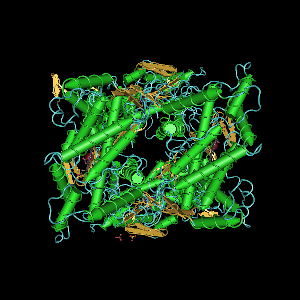Cytochrome P-450 CYP2D6: Difference between revisions
Jump to navigation
Jump to search

imported>Robert Badgett No edit summary |
John Leach (talk | contribs) m (Text replacement - "adverse drug reaction" to "drug-related side effects and adverse reactions") |
||
| (3 intermediate revisions by one other user not shown) | |||
| Line 2: | Line 2: | ||
{{Image|Mmdbimage-36878.png|right|350px|Crystal Structure of Human Cytochrome P450 2d6.}} | {{Image|Mmdbimage-36878.png|right|350px|Crystal Structure of Human Cytochrome P450 2d6.}} | ||
In [[biology]], the '''cytochrome P-450 CYP2D6''' is a "[[cytochrome P-450]] enzyme that catalyzes the hydroxylation of many drugs and environmental chemicals, such as debrisoquine; [[Adrenergic beta-antagonist|adrenergic receptor antagonist]]s; and [[tricyclic antidepressant]]s. This enzyme is deficient in up to 10 percent of the Caucasian population."<ref>{{MeSH}}</ref><ref>{{OMIM|608902}}</ref> | In [[biology]], the '''cytochrome P-450 CYP2D6''' is a "[[cytochrome P-450]] enzyme that catalyzes the hydroxylation of many drugs and environmental chemicals, such as debrisoquine; [[Adrenergic beta-antagonist|adrenergic receptor antagonist]]s; and [[tricyclic antidepressant]]s. This enzyme is deficient in up to 10 percent of the Caucasian population."<ref>{{MeSH}}</ref><ref>{{OMIM|608902}}</ref> | ||
CYP2D6 may be responsible for metabolism of 25% of prescribed drugs<ref name="pmid10723863">{{cite journal| author=Wolf CR, Smith G| title=Pharmacogenetics. | journal=Br Med Bull | year= 1999 | volume= 55 | issue= 2 | pages= 366-86 | pmid=10723863 | |||
| url=http://www.ncbi.nlm.nih.gov/entrez/eutils/elink.fcgi?dbfrom=pubmed&retmode=ref&cmd=prlinks&id=10723863 }} <!--Formatted by http://sumsearch.uthscsa.edu/cite/--></ref> and 38% of drugs frequently cited for causing [[drug toxicity]]<ref name="pmid11710893">{{cite journal| author=Phillips KA, Veenstra DL, Oren E, Lee JK, Sadee W| title=Potential role of pharmacogenomics in reducing drug-related side effects and adverse reactionss: a systematic review. | journal=JAMA | year= 2001 | volume= 286 | issue= 18 | pages= 2270-9 | pmid=11710893 | |||
| url=http://www.ncbi.nlm.nih.gov/entrez/eutils/elink.fcgi?dbfrom=pubmed&retmode=ref&cmd=prlinks&id=11710893 }} <!--Formatted by http://sumsearch.uthscsa.edu/cite/--></ref>. | |||
[[Paroxetine]] may increase death from [[breast cancer]] among women taking [[tamoxifen]] due to inhibiting metabolism of [[tamoxifen]] to its active metabolite by cytochrome P-450 CYP2D6.<ref>{{Cite journal | doi = 10.1136/bmj.c693 | volume = 340 | issue = feb08_1 | pages = c693 | last = Kelly | first = Catherine M | coauthors = David N Juurlink, Tara Gomes, Minh Duong-Hua, Kathleen I Pritchard, Peter C Austin, Lawrence F Paszat | title = Selective serotonin reuptake inhibitors and breast cancer mortality in women receiving tamoxifen: a population based cohort study | |||
| journal = BMJ | accessdate = 2010-02-10 | date = 2010-02-08 | url = http://www.bmj.com/cgi/content/abstract/340/feb08_1/c693 }}</ref> | |||
==External links== | ==External links== | ||
Latest revision as of 16:34, 10 February 2024
In biology, the cytochrome P-450 CYP2D6 is a "cytochrome P-450 enzyme that catalyzes the hydroxylation of many drugs and environmental chemicals, such as debrisoquine; adrenergic receptor antagonists; and tricyclic antidepressants. This enzyme is deficient in up to 10 percent of the Caucasian population."[1][2]
CYP2D6 may be responsible for metabolism of 25% of prescribed drugs[3] and 38% of drugs frequently cited for causing drug toxicity[4].
Paroxetine may increase death from breast cancer among women taking tamoxifen due to inhibiting metabolism of tamoxifen to its active metabolite by cytochrome P-450 CYP2D6.[5]
External links
- OMIM:
- Entrez Gene: 1565; PubMed: search
- Entrez Nucleotide: NG_008376; PubMed search
- Entrez Protein: 40805836; PubMed search
- Entrez Structure: 2F9Q
References
- ↑ Anonymous (2025), Cytochrome P-450 CYP2D6 (English). Medical Subject Headings. U.S. National Library of Medicine.
- ↑ Online Mendelian Inheritance in Man, OMIM®. Johns Hopkins University, Baltimore, MD. MIM Number: 608902. World Wide Web URL: http://omim.org/.
- ↑ Wolf CR, Smith G (1999). "Pharmacogenetics.". Br Med Bull 55 (2): 366-86. PMID 10723863.
- ↑ Phillips KA, Veenstra DL, Oren E, Lee JK, Sadee W (2001). "Potential role of pharmacogenomics in reducing drug-related side effects and adverse reactionss: a systematic review.". JAMA 286 (18): 2270-9. PMID 11710893.
- ↑ Kelly, Catherine M; David N Juurlink, Tara Gomes, Minh Duong-Hua, Kathleen I Pritchard, Peter C Austin, Lawrence F Paszat (2010-02-08). "Selective serotonin reuptake inhibitors and breast cancer mortality in women receiving tamoxifen: a population based cohort study". BMJ 340 (feb08_1): c693. DOI:10.1136/bmj.c693. Retrieved on 2010-02-10. Research Blogging.
